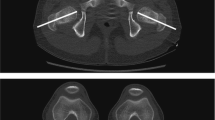Abstract
Purpose
The aim of our study was to produce a 3-D reconstruction of a CT dataset and compare it to the conventional method, with that same dataset, in terms of precision and the influence of femoral positioning.
Methods
A mechanical support was developed to rigidly fix the femur in a designated position. After measuring the real AT, a CT scan with different femur positions was performed. Eight cadaveric specimens were utilized for this study. Each examination was performed twice and the mean value was recorded. The Jend method was chosen as the conventional mode for femoral antertorsion measurement. In the 3-D reconstruction, the angle between the femoral neck and trailing edge of the femoral condyles was measured.
Results
Measurement of the AT by 3-D reconstruction (0.8°) was significantly better than the conventional method after (3.0°; P = 0.016). The positioning of the femur influences measurement of the femoral AT angle by conventional method measurement whereas evaluation using the 3-D reconstruction was more independent of femoral positioning.
Conclusion
3-D reconstruction enables precise determination of the femoral AT angle, and is independent of femoral positioning as conventional methods seem to be. In clinical practice, 3-D reconstruction may allow a greater understanding of the femoral AT angle post fracture reduction and internal fixation. However, we believe the 3-D method of measuring the AT-angle can potentially optimize the patient’s treatment outcome by allowing the orthopaedic surgeon to measure the femoral AT-angle more precisely after femoral fracture reduction.








Similar content being viewed by others
References
Billing L (1954) Roentgen examination of the proximal femur end in children and adolescents; a standardized technique also suitable for determination of the collum-, anteversion-, and epiphyseal angles; a study of slipped epiphysis and coxa plana. Acta radiologica 110:1–80
Bjersand AJ, Eastgate RJ (1982) The accuracy of CT-determined femoral neck anteversion. Eur J Radiol 2:1–4
Braten M, Terjesen T, Rossvoll I (1993) Torsional deformity after intramedullary nailing of femoral shaft fractures. Measurement of anteversion angles in 110 patients. J Bone Joint Surg Br 75(79):9–803
Citak M, Gardner MJ, Citak M et al (2007) Navigated femoral anteversion measurements—a new intraoperative technique. Injury
Davids JR, Marshall AD, Blocker ER et al (2003) Femoral anteversion in children with cerebral palsy. Assessment with two and three-dimensional computed tomography scans. J Bone Joint Surg Am 85-A:481–488
Failoni S, Vadala G, Dragonetti L, Simoncini F (1985) The value of computed tomography in the study of torsion of the lower limbs. Radiol Med (Torino) 71:409–412
Grimberg B, Soudry M, Chazar I et al (1993) Intramedullary nailing of mid-femoral fractures. Harefuah 124:543–546, 99
Groh GI, Parker J, Allen WC (1992) Fractures of the femur treated by intramedullary nailing using the fluted rod. A report of 193 consecutive cases. Clin Orthop Relat Res 22:3–8
Grote R, Elgeti H, Saure D (1980) Determination of the antetorsional angle at the femur with axial computer tomography. Rontgenblatter 33:31–42
Hernandez RJ, Tachdjian MO, Poznanski AK, Dias LS (1981) CT determination of femoral torsion. Ajr 137:97–101
Jaarsma RL, Pakvis DF, Verdonschot N et al (2004) Rotational malalignment after intramedullary nailing of femoral fractures. J Orthop Trauma 18:403–409
Jaarsma RL, Verdonschot N, van der Venne R, van Kampen A (2005) Avoiding rotational malalignment after fractures of the femur by using the profile of the lesser trochanter: an in vitro study. Arch Orthop Trauma Surg 125:184–187
Jend HH (1986) Computed tomographic determination of the anteversion angle. Premises and possibilities. Rofo 144:447–452
Keppler P, Strecker W, Kinzl L et al (1999) Sonographic imaging of leg geometry. Orthopade 28:1015–1022
Mesgarzadeh M, Revesz G, Bonakdarpour A (1987) Femoral neck torsion angle measurement by computed tomography. J Comput Assist Tomogr 11:799–803
Murphy SB, Simon SR, Kijewski PK et al (1987) Femoral anteversion. J Bone Joint Surg Am 69:1169–1176
Pfeifer T, Mahlo R, Franzreb M et al (1995) Computed tomography in the determination of leg geometry. In Vivo 9:257–261
Ricci WM, Bellabarba C, Lewis R et al (2001) Angular malalignment after intramedullary nailing of femoral shaft fractures. J Orthop Trauma 15:90–95
Rippstein J (1955) Determination of the antetorsion of the femur neck by means of two X-ray pictures. Z Orthop Ihre Grenzgeb 86:345–360
Strecker W, Keppler P, Gebhard F, Kinzl L (1997) Length and torsion of the lower limb. J Bone Joint Surg Br 79:1019–1023
Waidelich H-A, Strecker W, Schneider E (1992) Computed tomographic torsion-angle and length measurement of the lower extremity. The methods, normal values and radiation load. Fortschritt Röntgenstrahlung 157(3):245–251
Weiner DS, Cook AJ, Hoyt WA Jr, Oravec CE (1978) Computed tomography in the measurement of femoral anteversion. Orthopedics 1:299–306
Author information
Authors and Affiliations
Corresponding author
Rights and permissions
About this article
Cite this article
Citak, M., Oszwald, M., O’Loughlin, P.F. et al. Three-dimensional measurement of femoral antetorsion: comparison to a conventional radiological method. Arch Orthop Trauma Surg 130, 513–518 (2010). https://doi.org/10.1007/s00402-009-0923-8
Received:
Published:
Issue Date:
DOI: https://doi.org/10.1007/s00402-009-0923-8




